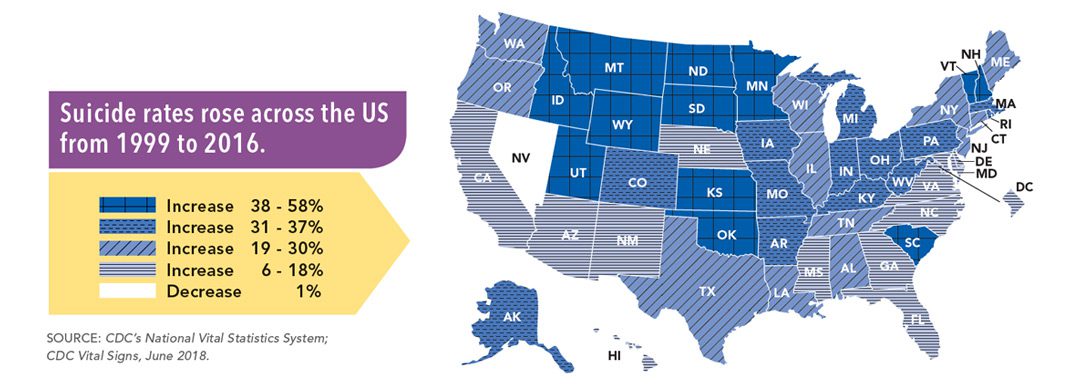September is National Suicide Prevention Month, when mental health advocates, prevention organizations, survivors, allies and community members unite to promote suicide prevention awareness. Relias is one such ally. We admire the strength of our clients who work daily to help prevent suicide and are committed to supporting other organizations doing the same. Relias is participating in National Suicide Prevention Month through September and beyond, by sharing helpful information, tools and resources across a variety of settings. Our intention is to emphasize the need for a comprehensive approach to suicide prevention so that we can meet the needs of individuals where they live, work and learn.
For the past 20 years, suicide prevention has been in the public eye and the number of deaths by suicide is growing. A different approach is needed Identifying the signs of suicide is important, but preventing suicide requires a societal commitment—bringing together neighborhoods, community organizations, schools, healthcare providers, governmental agencies and others to act on the signs and collectively make an impact.
While Americans have seen a 30% increase in suicide rates over the past 20 years, the rest of the world has seen a 29% decrease over the same amount of time.

What are other countries doing?
Other countries are taking action. Both the World Health Organization and the United Nations implemented action plans with goals to reduce suicide by 10% in 2020 (WHO) and by 33% in 2030 (U.N.).
Additionally, 38 countries launched their own national plans, several of which have been effective in reducing their suicide rates. Whether by limiting or removing the instruments used in suicide (pills, pesticides, guns) or by ramping up access to services, dozens of countries are recognizing the value and necessity of using a multipronged approach to prevent suicide. And, they’re seeing results.
As of April 2019, 100% of all local authorities in England have plans in place to prevent suicide.
For example, the U.K. launched the Zero Suicide Alliance, a collaborative of National Health Service trusts, businesses and individuals all committed to preventing suicide in the U.K. and beyond. They developed a free suicide prevention training available to all with a threefold purpose: to help people identify suicidal thoughts or behavior, to enable people to discuss suicide in a supportive way and to empower people to direct individuals to the right place for help.
England reduced their suicide rates through coordinated efforts between the government, the National Health Service, charities, the British Transport and others. In fact, as of April 2019, 100% of all local authorities in England have plans in place to prevent suicide.
And, while Switzerland had several resources available, they realized they needed to bring them together to be successful. With a goal of preventing 300 suicides per year, they created an online platform available to the public to simplify the way people seek advice, information and other resources.
The value of a comprehensive approach
Best friends Robert and Joe are walking around the track during their physical education (P.E.) class. After a few minutes, Robert shares some unpleasant things going on at home. Joe knows that Robert’s home life has been rough lately and that he has been feeling trapped.
After noticing a few odd comments, Joe recalls Robert’s suicide attempt last summer. Concerned, he asks Robert if he is thinking about suicide again.
Joe discovers that Robert is not only thinking about taking his own life, but has a specific plan to do so in the next couple of days. Joe pleads with him to seek help, but Robert refuses. When they get back to the locker room, Joe looks up the national suicide prevention lifeline and texts it to Robert, but he knows it isn’t enough.
Joe must do something, but he’s at school. Should he go to his P.E. teacher? The front desk? The guidance counselor? The principal? Would any of them know what to do? Let’s say they call 911. Do the police officer(s) know how to handle the welfare check appropriately? If they think Robert needs further evaluation and call for emergency medical services to transport him to the nearest emergency room, are the emergency room staff properly trained to assess his need for care?
Clearly, we can see the need for all these resources to be in alignment and carefully coordinated to help in Robert’s situation; but, where do we begin?
Where do we begin? With an expanded focus on training and education
We can start by collectively broadening our perception of who we “think” can help prevent suicide. That means moving beyond the mindset that it can only be discussed, addressed or prevented by behavioral health care providers or primary care physicians. Both of those professions are critical and highly valuable, but we also need to consider other areas where we live, work and learn—emergency room personnel, teachers, community organizations and others.
After we realize the need for a comprehensive approach, what next? Education. We need to educate ourselves, our staff, our teachers, our care providers and our communities on how to work together to prevent suicide. In a 2018 national study conducted by The Harris Poll, with support from the National Action Alliance for Suicide Prevention and the American Foundation for Suicide Prevention, while nearly 60% of Americans said they would encourage a friend or loved one to see a mental health professional, doctor or primary care professional, they recognize education must also play a part in helping lower suicide rates, especially with regard to the public, health care professionals and community leaders, as shown below.

If education is an important factor in suicide prevention, the U.S. is fortunate to have countless resources available and accessible to all. For example:
- Do you know how to identify the warning signs of suicide?
- Are you aware of the risk factors and common myths? For example, are you afraid that by asking someone if they’re thinking about suicide, it will prompt them to do it?
- Are you familiar with the five, #BeThe1To evidence-based action steps you can take to communicate with someone who may be suicidal?
- Do you work at a healthcare organization and want to improve your suicide prevention training?
- Do you know that there is a text line available if someone is in crisis but doesn’t want to speak with someone on the phone?
All the information above is helpful and valuable in helping to prevent suicide. Just remember—suicide prevention resources work best when shared, implemented and used collectively in a coordinated effort across our communities to save lives.
Does your organization already have a suicide prevention strategy in place? Learn how Relias improves suicide awareness and prevention training for professionals in the healthcare, human services and corrections industries.

Suicide Prevention: Science & Trends
Watch this webinar to learn about current trends, advocacy efforts in the US, and evidence-based best practices in suicide prevention and treatment.
Watch the webinar →





